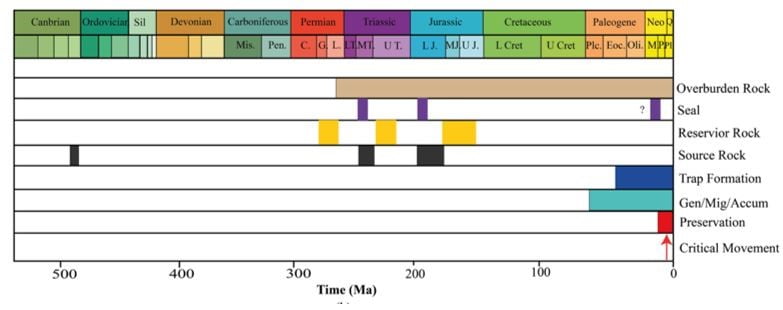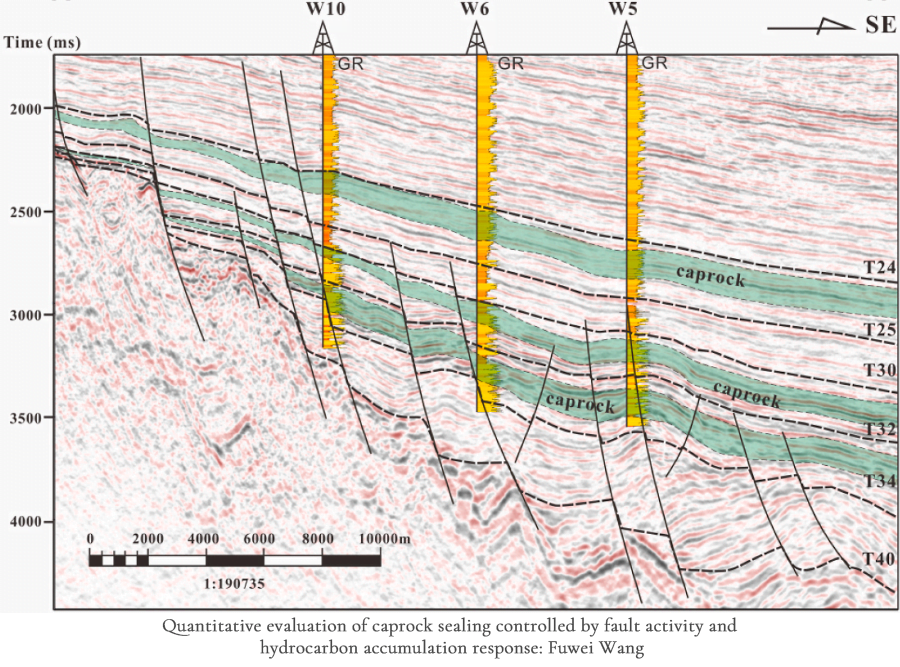The Prevailing Suspect: Migration Issues?
My recent work in an area dominated by the belief that source rock and migration pathways are the primary culprits for exploration failures intrigued my curiosity. A quick burial history analysis revealed that even on regional highs, potential and effective source rocks were within the oil window. A 2D regional transect from the recent literature indicated that the source rock is well within the gas window, corroborated by the abundant adjacent seeps. Given that the structure is valid, the reservoirs possess adequate porosity and permeability, and the source rock is in the maturity window with evidence of migration (seepages), what could go wrong in the area?

Figure 1 Petroleum System Elements
Timing: Not Always the Villain
Timing is often cited as the main culprit in such scenarios. However, the recent concept of migration lag challenges this notion. Here, timing didn’t seem to be the issue (Figure 1). While examining the petroleum system further, the only remaining element, the “SEAL,” came to the spotlight.

Figure 2X-Section showing a regional high
The Seal Under Scrutiny
Well logs and mud log painted a concerning picture. The main top seal lacked the typical characteristics of an effective seal (not clay-rich or even shale-rich). Instead, it comprised roughly 300 meters of loose sand, friable sandstone with some shale beds, indicating a low shale gouge ratio and poorly compacted beds with larger pore throats. The overburden pressure was simply not enough to adequately compact the seal rocks. William C. Dawson’s work on the influence of depositional conditions on shale properties and seal character resonated here. It made me question how established regional high (Figure 2) could be explored twice without proper assessment of the top seal’s ability to hold hydrocarbons. Does that mean that shallow reservoir targets are riskier regarding SEAL integrity? Not necessarily.
Why Seal Effectiveness is Often Ignored
Seal effectiveness is often the most challenging element to predict in exploration, hence its frequently neglected. In his LinkedIn blog, Alan Foum mentioned that a significant amount of technical work is done on reservoir prediction using sequence stratigraphy, sedimentology, and reservoir geology. Basin modeling or petroleum systems modeling (and geochemistry) examines the source and migration, reducing the risk on hydrocarbon charge and helping predict the hydrocarbon phase. Seismic interpretation defines the trap, and advanced seismic attributes further aid in reservoir characterization. Yet, seal prediction remains largely ignored. Let’s peg deeper into this issue and find out why it has entrenched in the exploration.
What makes the Seal Conundrum
A study titled “Central North Sea Post Well Analysis” revealed a concerning distribution of exploration failures: Seal (38%), Trap (28%), Reservoir (17%), and Charge (14%). Despite this significantly high number, seal prediction is often ignored due to the industry-wide dogma that seal effectiveness depends solely on facies, thickness, and lithology, ignoring that in all cases, sealing capability depends upon the radius of the pore throat, densities, and interfacial tension. As Zhiyong He explains, the inability to measure seal capacity from seismic data forces explorationists to rely on depositional environment-based ranges and probabilistic migration models. This explains why many geologists, particularly when dealing with thick shale-rich systems, take seals for granted, assuming even a few meters can hold a significant hydrocarbon column. However, thickness alone doesn’t determine seal capacity and column height.
Seal Failure: Friend or Foe? Rethinking a Contentious Concept
Alan Foum references J. Karlo’s video outlining various causes of seal failure (micro-porosity, brittle fractures, hydraulic fracturing, fault displacement, and fault rock composition). While these mechanisms are well-established, recent research has challenged the blanket application of some aspects of the ‘contentious seal failure concept.’ In light of this, let’s scrutinize more closely why seal integrity remains a neglected factor in the oil and gas industry.
Beyond Misconceptions: Rethinking Seal Capacity
Zhiyong He dispels two common misconceptions:
- Shales are not impermeable: All shales have some permeability, allowing migration when the capillary displacement pressure is exceeded. Over geological timescales, even very tight shales can accommodate migration.
- Leaking seals don’t necessarily mean no hydrocarbons: A seal exceeding its capacity by buoyancy will still trap the maximum column it can hold, just not more. This capacity is typically around 200-400 meters for good marine shale and much less for poor deltaic mudstone.
Conclusion: Seals Deserve Attention
- Seal rock integrity is a critical yet often overlooked factor in oil and gas exploration.
- The complexity and difficulty in predicting seal effectiveness is the main reason it is sidelined, despite its significant impact on exploration success.
- By understanding and examining the data related to seal rocks, explorationists can better evaluate the column a seal can retain.
- This requires additional data acquisition, which might seem trivial but is highly effective.
- Would you take SEALS for granted anymore?
References:
- Dawson, W. C., Almon, W. R., Dempster, K., & Sutton, S. J. Shale Variability in Deep-Marine Depositional Systems: Implications for Seal Character – Subsurface and Outcrop Examples. (https://www.searchanddiscovery.com/pdfz/documents/2008/08144dawson/ndx_dawson.pdf.html)
- Foum, A. (2018). Keeping the hydrocarbons in the trap, effective seals in petroleum exploration. LinkedIn. (https://www.linkedin.com/pulse/keeping-hydrocarbons-trap-effective-seals-petroleum-exploration-foum)
- He, Z. (2023). Capillary Seals and Petroleum Migration Observations, Modeling and Risking. (https://www.sodir.no/globalassets/2-force/2023/dokumenter/he-zhiyong-capillary-seals-and-petroleum-migration-force-webinar-nov-2023_final-with-notes.pdf)
- Karlo, J. (2018). [Video]. YouTube. (https://www.youtube.com/watch?v=F_YyEpfoj0s)
- Moray Firth – Central North Sea Post Well Analysis. (https://www.nstauthority.co.uk/media/1578/cnsmf_post_well_analysis_report.pdf)

